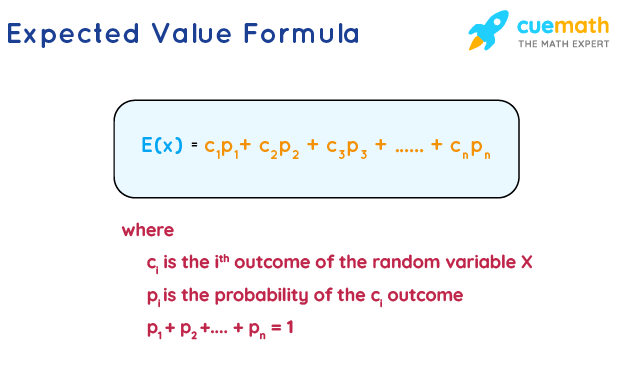Expected Value Formula
In probability and statistics, the expected value formula is used to find the expected value of a random variable X, denoted by E(x). It is also known as the mean, the average, or the first moment. In other words, the expected value is equal to the sum of the product of each possible outcome with its probability and is expressed as the formula for the expected value. If the probability of each outcome is equally likely, then the expected value is directly the arithmetic mean of all the outcomes. expected value formula is explained below along with solved examples.
What Is the Expected Value Formula?
The expected value formula is used to find the expected value which is a generalization of the weighted average. In the case of a discrete random variable, the expected value is calculated using the expected value formula which follows the addition of the value of the random variable and its associated probability.

Expected Value Formula
The expected value for a random variable X is given by
\(E(x) = c_1p_1 + c_2p_2 + c_3p_3 + ...... + c_np_n\)
where,
- \(c_i\) is the ith outcome of the random variable X and
- \(p_i\) is the probability of the \(c_i\) outcome and \(p_1 + p_2 + .... + p_n\) = 1
Applications of Expected Value Formula
Expected value is defined as the product of the probability and the value of each outcome.
- gives a quick insight into the behavior of any random variable.
- commonly used in finance as it indicates the anticipated value of future investments.
- used for decision-making in various fields.
Let us understand the expected value formula better using solved examples.

Examples using the Expected Value Formula
Example 1: There are 40 balls in a box, of which 35 of them are black and the rest are white. A player has to pay $100 to pick a ball randomly from the box. If the player gets a white ball, he wins $750. What is the expected profit of this bet?
Solution:
Let X represent the profit (can be negative) gained with a $100 bet. Using expected value formula,
E(X) = - (Prize for getting a black ball) × (Probability of getting a black ball) + (Prize for getting a white ball)×(Probability of getting a white ball)
= -(100) × (35/40) + 750 × (5/40) = - 87.5 + 93.5 = $5
Answer: The expected value of profit gained is $5.
Example 2: Using the expected value formula, find the expected value for the following probability distribution.
X |
1 |
2 |
3 |
4 |
P(X) |
0.20 |
0.10 | 0.45 | 0.25 |
Solution:
Using expected value formula,
E(X) = Σ\(X_iP(X_i)\) = 1 × 0.2 + 2 × 0.1 + 3 × 0.45 + 4 × 0.25 = 2.75
Answer: Expected value of the given distribution is 2.75.
Example 3: Random variable X has the following probability function:
X |
0 |
1 |
2 |
3 |
P(X) |
0.2 |
0.4 | 0.8 | 0.6 |
Solution:
Using expected value formula,
E(X) = (0 × 0.2) + (1 × 0.4) + (2 × 0.8) + (3 × 0.6) = 3.8
Answer: Expected value of the given distribution is 3.8.
FAQs on Expected Value Formula
What Is the Expected Value Formula in Probability?
The expected value formula is used to find the expected value which is a generalization of the weighted average. The expected value for a random variable X is given by, \(E(x) = c_1p_1 + c_2p_2 + c_3p_3 + ...... + c_np_n\), where \(c_i\) is the ith outcome of the random variable X and \(p_i\) is the probability of the \(c_i\) outcome and \(p_1 + p_2 + .... + p_n\) = 1
How To Use the Expected Value Formula?
In a discrete random variable, the expected value is calculated as follows
- Step 1: Find the product of the value of the random variable and its associated probability for each of the given variables.
- Step 2: Add all the values as obtained from step 1.
What Are the Components of Expected Value Formula?
The expected value for a random variable X is given by, \(E(x) = c_1p_1 + c_2p_2 + c_3p_3 + ...... + c_np_n\), where \(c_i\) is the ith outcome of the random variable X and \(p_i\) is the probability of the \(c_i\) outcome and \(p_1 + p_2 + .... + p_n\) = 1
What Is Conditional Expected Value Formula?
The conditional expectation, E(X |Y = y), is a number depending on y. If Y has an influence on the value of X, then Y will have an influence on the average value of X.
visual curriculum
